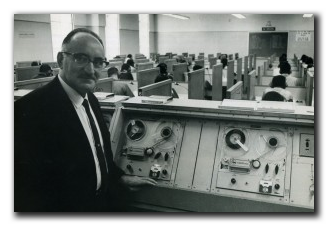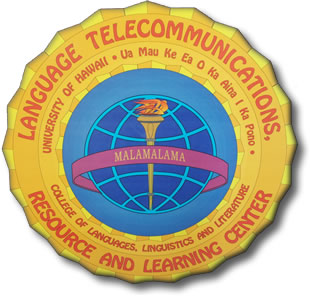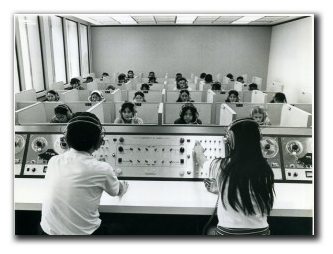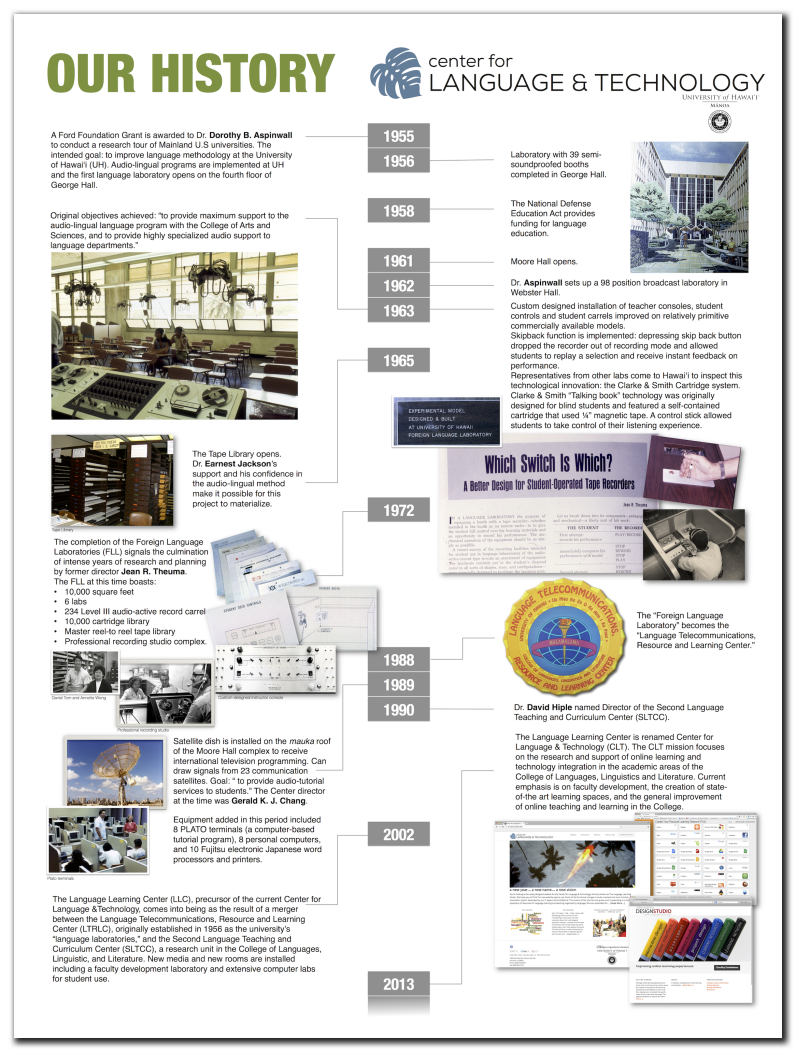
Rendering of Moore Hall, University of Hawai‘i at Mānoa
The University of Hawai‘i foreign language program as it stands today was originally initiated by two leaders in the field of European languages. In the Spring of 1955, Dr. Dorothy B. Aspinwall received a Ford Foundation grant to conduct a research tour of mainland universities in an effort to improve language teaching methodology at the University of Hawai‘i. Successful completion of this research project enabled Dr. Aspinwall to set the course of the University’s audio-lingual programs by pioneering our first language lab installation on the fourth floor of George Hall. This initial installation was completed in 1956, two years before the National Defense Education Act. Again in 1962, it was her leadership that enabled us to acquire our 98-position broadcast laboratory located in Webster Hall. Finally, installation of our 35-position library lab in 1965 would not have materialized without Dr. Earnest Jackson’s support and his faith in the audio-lingual method. Statistics on lab activities indicate that between 1962 and 1968, the University’s foreign language programs had more than tripled, and student enrollment more than doubled. It became apparent that the then existing facilities in Webster Hall were not adequate to cope with the increase program load and student enrollment. Plans for our latest installation were drawn up. December 31, 1972, marked the official completion date of the installation of the Foreign Language Laboratories complex at the University of Hawaii’s Manoa campus. This language laboratory facility is the culmination of eight years of intensive research and planning program, initiated by it former Director, Jean R. Theuma, resulting in a custom prototype installation.

Prof. Jean R. Theuma in a language laboratory in Moore Hall, University of Hawai‘i at Mānoa
The LLC, in its present structure since 2002, is the result of a merger between two previously existing centers: (1) the Language Telecommunications, Resource and Learning Center (LTRLC), originally established in 1956 as the university’s “language laboratories,” and (2) the Second Language Teaching and Curriculum Center (SLTCC), founded in 1989 with a rotating directorship and a small budget to focus on teacher training and the development of pedagogical materials.
David Hiple was employed as the first permanent director of the SLTCC in 1992. When the long-time director of the LTRLC left UH in 1995, the then Dean of the College of Languages, Linguistics & Literature (LLL), Dr. Cornelia Moore, commissioned an external evaluation of that center by Jackie Tanner, Director of Language Learning Technology at Georgetown University. Among the 1995 report recommendations were that:
- the LTRLC move from just an audio facility to one that “should offer full media services to teachers as well as instructional and technical workshops”;
- the staff job descriptions be rewritten to take those new, multiple goals into account;
- a one-year temporary director be named until a permanent Director can be hired.

First Center logo
In line with these recommendations, Dean Moore named a temporary LTRLC director in 1996 for one year. The following year, David Hiple was appointed as LTRLC director and simultaneously continued in his capacity as SLTCC director. Tanner’s recommendations were subsequently implemented, mostly under the directorship of David Hiple who became the permanent director in 2001. Under Hiple’s directorship, the LTRLC and SLTCC were merged in 2002 and became the LLC. The Language Learning Center is now a thriving unit that, thanks to a gradual and successful reorganization, has come a long way and now provides an unprecedented level of service. The fact that the LLC directorship is now a tenured position is an illustration of the high academic regard in which that role is viewed – and justifiably so.

The LTRLC office
In 2002 David Hiple secured university approval for LLC to operate an “enterprise account,” allowing the center to sell products and services, collect and hold revenues, and make purchases. Given that the LLC receives no technology budget from the university, it is largely with enterprise account revenues that the center has been able to buy hardware and convert and upgrade facilities. In recent years, four antiquated audio-lingual cassette laboratories from the LTRLC era have been decommissioned and dismantled, and a suite of new multimedia computer laboratories and media rooms has been installed, including a faculty development lab. This is a significant accomplishment that has enhanced the LLC’s reputation on campus and in the profession and facilitated the integration of innovative language pedagogy with technology.
David Hiple also served as the Associate Director of the College of LLL’s National Foreign Language Resource Center. Over time, as the focus of the NFLRC has inevitably come to include more and more technology-enhanced projects, the missions of the LLC and NFLRC have converged, even though the former has a campus focus and the latter has a national focus. In this regard the staffs of the two centers have blended, so that they can perhaps best be regarded as two partially overlapping sets, with each staff member having some unique functions and sharing some common functions.

Language laboratory carrels
As a federally funded center, the NFLRC grant represents over $3,700,000 in external funds awarded to the College of LLL in roughly the last ten years. During the same period, the LLC received approximately $1,185,000 in related grants and contracts from such sources as the US Department of Education, the National Security Education Program, and the American Council on the Teaching of Foreign Languages. The revenues and the activities carried out in the funded projects have brought significant tangible and intangible resources to LLC and the teaching and learning community in the College of LLL.
In 2012, the Language Learning Center welcomed a new director, Dr. Julio Rodriguez. Dr. Rodriguez comes to us from Iowa State University, where he was Director of Curriculum Development for Online Learning in the College of Liberal Arts and Sciences and the College of Engineering and Adjunct Assistant Professor in the Department of World Languages and Cultures. If you are interested in current trends in computer-assisted language learning (CALL), be sure to talk to Dr. Rodriguez. With a solid track record of conference presentations and publications in the field, Dr. Rodriguez brings to LLC the strength of his background in integrating technology in language education. Last semester during his campus visit, LLL faculty enjoyed a talk by Dr. Rodriguez titled “Open Projects, Open Possibilities” on combining multiple open-source technologies in a single instructional sequence for Spanish. His experience with mashups, social media, and other technologies in language teaching is a rich treasure trove waiting to be mined by LLL faculty. And his background in curriculum development will be helpful for faculty interested in integrating a project-based model for the application of technology rather than a scattershot or “menu-based” approach.
In 2013, The Language Learning Center is renamed Center for Language & Technology (CLT). The CLT mission focuses on the research and support of online learning and technology integration in the academic areas of the College of Languages, Linguistics & Literature. Current emphasis is on faculty development, the creation of state-of-the art learning spaces, and general improvement of online teaching and learning in the College.
In 2020, the College of Languages, Linguistics and Literature merged with the College of Arts & Humanities and the School of Pacific and Asian Studies to form the College of Arts, Languages & Letters (CALL). CALL encompasses the study of the arts, humanities, languages, area studies, and human communication sciences on a global scale, with a rigorous emphasis on Hawaiʻi, the Pacific and Asia through our degree programs and interdisciplinary centers and initiatives. The College houses seventeen academic departments, the School of Pacific and Asian Studies, and multiple research and national resource centers. CALL’s strengths are considerable, from the creative arts to the language sciences, from the core liberal arts to emerging interdisciplinary collaborations across our College and with other academic programs at Mānoa. CALL Statement of Goals by Dean Peter Arnade.



